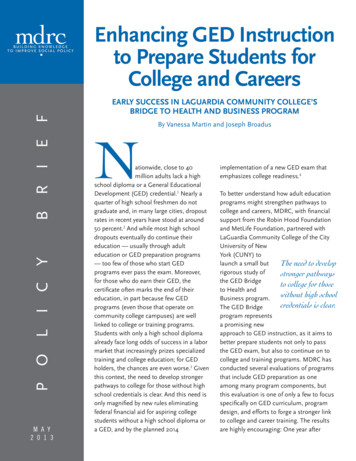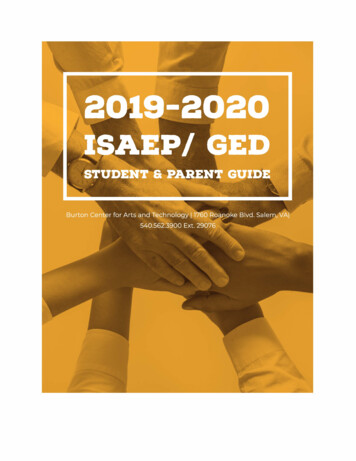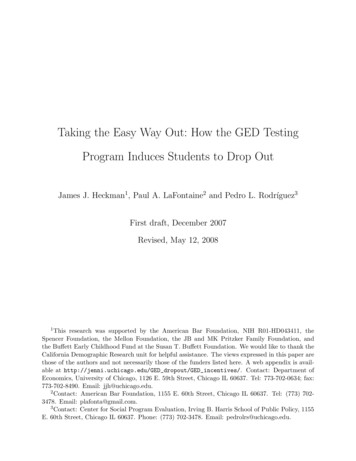
Transcription
BUILDING ONTHE GEDPromising Results from aBridge-to-College ModelLouisa TreskonYana KusayevaJohanna WalterMay 2020
Building on the GEDPromising Results from aBridge-to-College ModelLouisa TreskonYana KusayevaJohanna WalterMAY 2020
FUNDERSThis evaluation was supported by Arnold Ventures.Dissemination of MDRC publications is supported by thefollowing organizations and individuals that help financeMDRC’s public policy outreach and expanding efforts tocommunicate the results and implications of our work topolicymakers, practitioners, and others: The Annie E. CaseyFoundation, Arnold Ventures, Charles and Lynn SchustermanFamily Foundation, The Edna McConnell Clark Foundation,Ford Foundation, The George Gund Foundation, Daniel andCorinne Goldman, The Harry and Jeanette Weinberg Foundation, Inc., The JPB Foundation, The Joyce Foundation, TheKresge Foundation, and Sandler Foundation.In addition, earnings from the MDRC Endowment help sustain our dissemination efforts. Contributors to the MDRCEndowment include Alcoa Foundation, The Ambrose MonellFoundation, Anheuser-Busch Foundation, Bristol-MyersSquibb Foundation, Charles Stewart Mott Foundation, FordFoundation, The George Gund Foundation, The Grable Foundation, The Lizabeth and Frank Newman Charitable Foundation, The New York Times Company Foundation, Jan Nicholson, Paul H. O’Neill Charitable Foundation, John S. Reed,Sandler Foundation, and The Stupski Family Fund, as well asother individual contributors.The findings and conclusions in this report do not necessarilyrepresent the official positions or policies of the funders.For information about MDRC and copies of our publications,see our website: www.mdrc.org.Copyright 2020 by MDRC . All rights reserved.
OVERVIEWBridge-to-college programs aim to help people complete high school and enroll in postsecondary education, two milestones that increase access to economic opportunity. These programs help students obtaintheir high school credentials while encouraging postsecondary transition and success.Northeast Wisconsin Technical College (NWTC) in Green Bay, Wisconsin, implemented a bridge-tocollege program in 2015 to help more students earn their GED credentials and transition to postsecondary education. This GED Bridge program had three components that distinguished it from NWTC’straditional GED class, called GED Prep 2: (1) a NWTC-developed “contextualized” curriculum — onethat focused on original texts and materials related to specific careers (to build students’ academic skillsand raise their awareness of those careers) — in contrast to GED Prep 2 classes that focused on GEDtest preparation materials; (2) individual support to help students plan their transition to postsecondaryeducation, plus career exploration and transition planning in class; and (3) managed cohort enrollment,meaning that students started each class section together, in contrast to the open enrollment of the GEDPrep 2 class where new students could enroll at any time.This report describes an evaluation of NWTC’s GED Bridge program that included impact, implementation,and cost analyses. The impact analysis employed a random assignment design. Eligible applicants wererandomly assigned to either the GED Bridge class or the GED Prep 2 class and followed for 18 months.The research team used administrative data to measure differences in class attendance and persistence,GED testing and completion, and enrollment in postsecondary education.KEY FINDINGS Students in the GED Bridge classes generally received the contextualized curriculum, managed cohortenrollment, and enhanced planning and support for transition to postsecondary education. Theseexperiences differed from those of students in the traditional GED Prep classes, though they differedto varying degrees from semester to semester. Students assigned to the GED Bridge program had significantly higher rates of GED class attendanceand attended those classes over a longer period. GED Bridge group students were more likely to earn GEDs and enroll in college courses. GED Bridgeincreased the percentage of students who earned GEDs by 11.7 percentage points and increased enrollment into college courses by 8.5 percentage points. As implemented at NWTC, the GED Bridge program was more expensive than GED Prep 2 and was notas cost-effective (meaning it did not result in a lower cost per GED credential earned). Its higher costswere in part a result of how NWTC staffed the GED programs and enrolled students, which resultedin more experienced teachers in GED Bridge classes and smaller student-teacher ratios. Students inGED Bridge also stayed in the program longer and received transition support not available to GEDPrep 2 students, which increased costs.This evaluation contributes to a small but growing body of research that suggests that bridge-to-collegeprograms may be effective in improving both GED completion and postsecondary enrollment.Building on the GED: Promising Results from a Bridge-to-College Model iii
CONTENTSOVERVIEWiiiLIST OF EXHIBITSviiACKNOWLEDGMENTSixEXECUTIVE SUMMARYES-1Introduction1GED Programs at Northwest Wisconsin Technical Collegeand This Evaluation4Program Implementation9Program Impacts14Costs17Implications and Further Research21REFERENCES23Building on the GED: Promising Results from a Bridge-to-College Model v
LIST OF EXHIBITSTABLE1Comparison of GED Bridge and GED Prep 2 Classes2Demographics of the Full Study Sample103Receipt of Transition Services by GED Bridge Group Students During the18-Month Follow-Up Period1242017 Annual Total Costs185Estimated Gross and Net Costs for GED-Related Activities Within an18-Month Follow-Up Period, by Program (in 2017 Dollars)196FIGUREES.1Percentage of Students Who Enrolled in a College Course or Earned a GEDCertificate at NWTC1GED Class Attendance After 18 Months of Enrollment142Impacts on GED Testing and Receipt 18 Months After Random Assignment153Impacts on Postsecondary Activities at NWTC 18 Months After RandomAssignment16Building on the GED: Promising Results from a Bridge-to-College ModelES-3 vii
ACKNOWLEDGMENTSThe research team would like to thank our partners at Northeast Wisconsin Technical College (NWTC)for their support of this project. We would particularly like to thank Pamela Gerstner, associatedean of general studies, and Diane Shilka for their leadership and guidance. We also thank NWTCleaders for their support of this project, including H. Jeffery Rafn, president; Lori Suddick, formervice president of learning; and Michaeline Schmit, dean of general studies. We would like to thankthe NWTC staff members who developed the curriculum for the GED classes and were dedicatedteachers to their students, including Holli Lewandowski, Heather Anderson Cox, Jo Allison Scott,and Amy Schultz. Jessica Walker Beaumont also provided support for marketing and recruitment.We also thank LaGuardia Community College for inspiring NWTC to develop a GED bridge-tocollege program and for providing programmatic technical assistance. In particular, we would liketo thank Amy Dalsimer and Wynne Ferdinand who providing training and ongoing support.We also acknowledge all the staff members at MDRC who supported this project throughout the years.Thanks especially to Christine Johnston, Kate Gualtieri, Vanessa Martin, and Mifta Chowdhury fortheir significant contributions to the project’s direction, design, implementation, operations, andearly evaluation. We also thank Johanna Walter for guiding the cost and impact analysis for thereport, as well as Dannia Guzman and Sally Dai, who analyzed the data. We are grateful to DanBloom, Dan Cullinan, John Hutchins, and Elizabeth Zachry, who reviewed the draft report andprovided insightful comments. Finally, the authors thank Jill Verrillo, Vicky Ho, and Abby Durganfor coordinating production, Will Swarts and Joshua Malbin for reviewing and editing, and CarolynThomas for designing the report and preparing it for publication.Finally, we are extremely thankful to the GED students at NWTC who agreed to be part of this study.Without them, this project would not have been possible.The AuthorsBuilding on the GED: Promising Results from a Bridge-to-College Model ix
EXECUTIVE SUMMARYMost jobs require at least a high school diploma or equivalent, and those that do not are mainly lowwage jobs with few opportunities for advancement.1 An estimated 10 percent of the U.S. populationover age 25 lack a high school credential. 2 People without high school degrees make less on averagethan those of all other education levels and have the highest unemployment rates. 3Given these statistics, many states and cities focus their education policies on increasing high schoolcompletion rates, and also postsecondary enrollment and completion rates. One pathway to highschool completion is a high school equivalency diploma. The General Educational Developmentcredential, or GED, can open access to postsecondary programs that require a high school diploma.However, alternative diploma holders have not typically made the transition to postsecondary education at the same rate as traditional high school graduates. 4 Extensive research finds that GED holders fare only marginally better in the labor market than people who do not complete high school. 5Developing better programs to help these adult learners earn high school equivalency credentialsand make a successful transition to postsecondary education has the potential to advance this groupon pathways to quality jobs — ones that offer living wages, benefits, and opportunities for advancement — and self-sufficiency.One approach, bridge-to-college programs, seeks to help students complete high school and beginpostsecondary enrollment by simultaneously helping them obtain their high school credentialswhile providing support to encourage transitions to and success in postsecondary education. Thisreport, prepared by MDRC, a nonprofit, nonpartisan research organization, describes an evaluationof one bridge-to-college program at Northeast Wisconsin Technical College (NWTC) in Green Bay,Wisconsin; the program aimed to help students earn their GEDs and continue to postsecondary1 In 2016, 28 percent of jobs required no educational credential, including retail and custodial jobs. SeeBureau of Labor Statistics, “37 Percent of May 2016 Employment in Occupations Typically RequiringPostsecondary Education” (Washington, DC: U.S. Department of Labor, 2017).2 U.S. Census Bureau, “Educational Attainment in the United States: 2018” (Washington, DC: U.S. CensusBureau, 2019).3 Elka Torpey, “Data on Display: Measuring the Value of Education” (Washington, DC: U.S. Department ofLabor, 2018).4 Each state has its own requirements for high school equivalency tests. The GED is the most common test,available in 40 states. The High School Equivalency Test (HiSET) is available in 23 states, and the TestAssessing Secondary Completion (TASC) is available in 15 states. The National External Diploma Programis the least common test, available in only 6 states. Brian Smith and C.T. Turner, “GED Program Update:How to Thrive in this New WIOA World” (website: www.GEDtestingservice.com, 2018); Educational TestingService, “2017 Annual Statistical Report on the HiSET Exam” (website: http://hiset.ets.org, 2017); TestAssessing Secondary Completion, “2015 Annual Statistical Report” (Maple Grove, MN: Data RecognitionCorporation, 2016); National External Diploma Program, The NEDP: Yearly Statistical Report (San Diego,CA: CASAS, 2016).5 James Joseph Heckman, John Eric Humphries, and Nicholas S. Mader, “The GED” (Bonn, Germany: IZAInstitute of Labor Economics, 2010).Building on the GED: Promising Results from a Bridge-to-College Model ES -1
education. The findings from this evaluation contribute to a small but growing body of researchthat suggests that bridge-to-college programs may be effective in improving both GED completionand postsecondary enrollment rates.THE GED BRIDGE TO COLLEGE PROGRAM AT NWTCNWTC offers adult basic education classes in addition to college and occupational training classes.Beginning in 2015, NWTC developed a new bridge-to-college curriculum for its GED preparationclasses, called GED Bridge to College and Careers. The new program was inspired by a similar oneat LaGuardia Community College in New York City that had already shown evidence of success. 6This class had three components that distinguished it from NWTC’s traditional GED classes, calledGED Prep 2:1. The GED Bridge class used a NWTC-developed “contextualized” curriculum — one that focusedon original texts and materials related to specific careers (to build students’ academic skills andraise their awareness of those careers) — in contrast to GED Prep 2 classes, which focused onGED test-preparation materials.2. GED Bridge students received individual support to help them plan their transition to postsecondary education, plus career exploration and transition planning in class, which were notavailable to GED Prep 2 students.3. The GED Bridge class implemented managed cohort enrollment, meaning that students startedeach seven-week class section together, in contrast to the open enrollment of the GED Prep 2class where new students could enroll at any time.EVALUATION AND RESULTSTo test the effectiveness of the GED Bridge class, MDRC randomly assigned eligible applicants toNWTC’s GED classes to either the GED Bridge class (the GED Bridge group) or the GED Prep 2class (the GED Prep 2 group), and followed their results for 18 months. The study tracked rates ofGED attainment and enrollment into postsecondary education at NWTC. The GED Bridge groupstudents attended GED classes, earned GED credentials, and enrolled in college classes at significantly higher rates than the GED Prep 2 group: Figure ES.1 shows that 11.7 percentage points morestudents assigned to the GED Bridge class earned their GEDs (33.2 percent for GED Bridge groupstudents compared with 21.5 percent for GED Prep 2 group students). GED Bridge group studentsenrolled in college courses at a higher rate as well: 19.9 percent of GED Bridge group students tookcollege courses, compared with 11.4 percent of GED Prep 2 group students — a 75 percent difference.6 For results from the LaGuardia study, see Vanessa Martin and Joseph Broadus, Enhancing GEDInstruction to Prepare Students for College and Careers: Early Success in LaGuardia CommunityCollege’s Bridge to Health and Business Program (New York: MDRC, 2013).ES-2 Building on the GED: Promising Results from a Bridge-to-College Model
FIGURE ES.1 Percentage of Students Who Earned GED Certificatesor Enrolled in College Courses at NWTC33.211.7**21.58.5**19.911.4Earned GED certificates (%)GED BridgeEnrolled in college courses at NWTC (%)GED Prep 2SOURCE: Calculations based on administrative data from NWTC.NOTES: Statistical significance levels are indicated as: *** 1 percent; ** 5 percent;* 10 percent.Results in this table are regression-adjusted, controlling for pre-random assignmentcharacteristics.Rounding may cause slight discrepancies in calculating sums and differences.The total sample of 340 students includes 169 students in GED Bridge and 171students in GED Prep 2.The GED Bridge program’s costs were higher than those of the GED Prep 2 classes. An analysis foundthat those higher costs could be attributed to lower staff-to-student ratios for GED Bridge, higherinstructional costs from using more experienced staff members to teach the GED Bridge classes,staffing for transition support, and longer persistence in the program by GED Bridge group members.These findings, combined with results from the earlier study at LaGuardia, suggest that elementsof these bridge-to-college programs — primarily a contextualized curriculum, cohort enrollment,and focused support for postsecondary transitions — can boost persistence in GED classes, GEDcompletion rates, and postsecondary enrollment rates. These findings now apply to the small shareof GED classes that take place on college campuses, but these lessons can also be instructive forprogram operators seeking to improve the community-based GED preparation classes that are moreprevalent. More broadly, the findings in this report align with recent federal and state policies thatencourage these approaches, and with other research that has found that integrating basic skillsclasses with instruction on college and career readiness can improve outcomes for adult learners.77 See, for example, the Workforce Innovation and Opportunity Act, Public Law 113-128. (U.S. Statutes atLarge, 2014); Matthew Zeidenberg, Sung-Woo Cho, and Davis Jenkins, Washington State’s IntegratedBasic Education and Skills Training Program (I-BEST): New Evidence of Effectiveness (New York:Columbia University, 2010).Building on the GED: Promising Results from a Bridge-to-College Model ES-3
INTRODUCTIONMost jobs require at least a high school diploma or equivalent, and those that do not are mainlylow-wage jobs with few opportunities for advancement.1 Quality jobs with living wages, benefits,and opportunities for advancement typically require people to complete high school. People without high school degrees make less on average than people of all other education levels and have thehighest unemployment rates. 2 Most postsecondary education and training programs require highschool completion as a criterion for enrollment, and postsecondary education in turn leads to higherearnings. 3 Though high school completion rates are on the rise, an estimated 10 percent of the U.S.population over age 25 lack a high school credential — 11.3 million people between the ages of 25and 54. Postsecondary education rates are even lower — an estimated 35 percent of 25- to 54-yearolds do not have any postsecondary education. 4Given these statistics, many states and cities focus their policies on increasing high school completion rates, and on improving postsecondary enrollment and completion rates. Many reforms aim toimprove high school graduation rates by preventing students from dropping out. Other efforts tryto reengage young people who have left school. One approach, bridge-to-college programs, targetsboth high school completion and college enrollment rates by helping students obtain their secondary credentials while simultaneously providing support to encourage postsecondary transition andsuccess. This report focuses on the bridge-to-college program at Northeast Wisconsin TechnicalCollege (NWTC) in Green Bay, Wisconsin, aimed at helping those who have left high school andare at least 18.5 years old earn GED certificates and continue to postsecondary education. MDRC,a nonprofit, nonpartisan research organization, conducted an evaluation of NWTC’s GED Bridgeprogram. The findings from this evaluation contribute to a small but growing body of researchindicating that bridge-to-college programs may be effective in improving GED completion andpostsecondary enrollment.The GED Test: History, Purpose, and ValueThe General Educational Development, or GED, certificate was first introduced in 1942 as an alternative to a high school diploma for people in the military who were deployed overseas before theycould finish high school. 5 The underlying principle of the GED and similar tests is that it assesses thesame skills that students learn in high school. Therefore, people who pass the test can be consideredto have skills similar to those of high school graduates. The GED is the most common alternative1. U.S. Department of Labor, Bureau of Labor Statistics (2017) reports that 28 percent of jobs require noeducational credential, including retail and custodial jobs.2. Torpey (2018).3. U.S. Department of Labor, Bureau of Labor Statistics (2019).4. U.S. Census Bureau (2019). In 2016, 93 percent of 18- to 24-year-olds had obtained a high school diplomaor equivalent (including the GED), compared with 86 percent in 2000. High school graduation rates havealso increased. In 2016, 84 percent of high school students graduated within four years, compared with79 percent in 2010. See U.S. Department of Education, National Center for Education Statistics (2017,2019); Stetser and Stillwell (2014).5. Tyler (2005).Building on the GED: Promising Results from a Bridge-to-College Model 1
to a high school diploma, though other tests have gained popularity in recent years. 6 The GED andsimilar credentials provide a crucial option for high school completion outside of a traditional highschool diploma.GED recipients are diverse: Some people who pursue a GED or its alternatives are young and recentlyleft school but still seek a path to a high school credential. Other people may have left high schooldecades ago and are seeking a GED to be able to advance in the labor market or are pursuing thecredential for personal reasons. Demographic information reported by the GED Testing Service in2017 showed that the average age of a GED tester was 26, and 45 percent had completed eleventhgrade or higher. Nearly a third were looking for work, and 40 percent were working full or part time.7The GED test is in its fifth version since its introduction in 1942. The latest revision came in 2014in an effort to increase the rigor of the test as most states strengthened high school graduationstandards under the 2010 federal Common Core. (The Common Core sets standards to define whatknowledge and skills students should have mastered by graduation in order to succeed in entry-levelcareers and postsecondary training programs.) 8 Research before 2014 found that GED recipients didnot have labor market outcomes as good as those of high school graduates. 9 The test redesign wasintended to address these criticisms by aligning the GED with Common Core standards and testingstudents on the skills and knowledge required for them to make the transition to postsecondaryeducation or training, and ultimately to careers.10 Pass rates fell in the first year after the new testwas implemented in 2014, but have since rebounded.11Nationwide, fewer students are taking the GED test than have in the past. The number of GEDcertificates awarded fell by nearly half between 2012 and 2017 (from 465,095 in 2012 to 237,426 in2017).12 In Wisconsin, the number of GED certificates awarded fell by 60 percent, from 7,100 in2012 to 2,900 in 2016.13 Since GED pass rates have rebounded, they do not explain the decline in thenumber of GED certificates awarded. The decline may be partly explained by the rise of other tests6. Other tests include the High School Equivalency Test (HiSET), available in 23 states; the Test AssessingSecondary Completion (TASC), available in 15 states; and the National External Diploma Program,available in 6 states. See Smith and Turner (2018); Educational Testing Service (2017); Test AssessingSecondary Completion (2015); National External Diploma Program (2016).7. Smith and Turner (2018).8. Common Core State Standards Initiative (2020).9. Cameron and Heckman (1993); Heckman, Humphries, and Mader (2010).10. Hoffman, Wine, and McKinney (2013). The main differences between the pre-2014 test and the currenttest are: (1) The content of the new test is aligned with the Common Core and focused on skills relatedto college and career readiness. (2) The new test includes constructed-response questions aimed atmeasuring complex thinking and depth of knowledge, rather than full multiple-choice questions. (3) Thenew test is computer-based rather than pen and paper. (4) The revised test focuses more on critical andanalytical thinking skills, while the prior test focused on reading fluency and comprehension.11. The U.S. Department of Education, Office of Career, Technical, and Adult Education (2019) shows passrates dipping in program year 2014-2015 for high school completion supported by Title II of the WorkforceInnovation and Opportunity Act, but rebounding in program year 2015-2016.12. These calculations are based on data in Gewertz (2018).13. Hillard (2018).2 Building on the GED: Promising Results from a Bridge-to-College Model
offering more options for high school completion.14 Rising high school graduation rates may alsoaccount for part of the decline, as schools move to improve graduation rates and offer new pathwayssuch as alternative schools for students to complete traditional diplomas, lowering the number ofstudents needing the GED.The current GED is made up of four subject tests (mathematical reasoning, reasoning throughlanguage arts, social studies, and science), which students take separately at their own pace on acomputer. The cost to take the test varies by state, and there are often financial aid options available.Eligibility to take the GED also varies from state to state and often includes minimum age requirements to discourage high school students from pursuing a GED instead of a traditional diploma.Prospective test takers can prepare for the exam in a variety of ways, including self-study usingGED workbooks, online preparation programs, and classes. The range of classes includes onlineinstruction, drop-in classes offered by community-based organizations, libraries and churches, andclasses offered through school districts and community colleges. Many free GED test preparationclasses are available, but these programs typically operate on small budgets. Teacher qualifications inthese programs run the gamut, from community volunteers to dedicated full-time faculty; programstructures range from online programs to daily in-person classes, as do curricula, from GED testworksheets to college-preparation content.Transitions to Postsecondary Education for GED RecipientsImproving the share of GED students who persist in GED programs and earn the credential is animportant goal on its own, as this milestone can open the door to jobs that are only available topeople with high school credentials. Still, today’s labor market demands postsecondary trainingto gain access to most quality jobs. But research shows that GED recipients enter and persist inpostsecondary education at lower rates than traditional high school graduates.15 Research beforethe 2014 test change found that while 73 percent of high school diploma recipients completed somepostsecondary education, only 43 percent of GED holders did.16 Independent research is not available to show whether the revised 2014 GED test has changed these trends.Schools, colleges, and governments continue to work on improving the rate at which students in adulteducation make the transition to postsecondary education.17 The results include new models focusedon integrating adult basic skills programs with workforce and postsecondary preparation training toput students on career pathways that lead to success in the labor market. Bridge-to-college programscombine academic preparation for college-level work with various forms of support to encourage14. The rise of other tests cannot explain all of the decline in GED certificates, however, since a nationwideanalysis of high school equivalency attainment found that the number of certificates awarded from TASC,GED, and HiSET, among other tests, fell by more than 40 percent during the period between 2012 and2016. Hillard (2018).15. Tyler and Lofstrom (2010).16. Ewert (2012).17. Zachry Rutschow, Beal, and Johnson (2019). Adult education includes basic skills education for thosebelow ninth-grade proficiency, English language proficiency, high school completion, and college andworkforce readiness programs.Building on the GED: Promising Results from a Bridge-to-College Model 3
students to make the transition to college, including career planning and assistance navigating college application, financial aid, and registration processes.18 Not all bridge-to-college programs focuson the subgroup of people seeking GEDs — they are also in high schools and programs for peoplewho already have their high school credentials and are exploring the next step in their education.State and college approaches to improving adult education also include career pathways and contextualized instruction. Career pathways approaches identify occupations where the supply of qualifiedapplicants does not meet the labor market’s demand, and tailor education and training programsaimed at low-income, low-skill populations to try to fill those gaps. Contextualized instructionrefers to the instructional strategy that grounds academic or skill-building concepts in real-worldexamples and materials (for example, teaching math concepts by discussing how they are appliedin a health care setting).19 The reauthorization of the Workforce Innovation and Opportunity Actin 2015 emphasized such models. 20To date, there have been only a few evaluations of the effectiveness of GED bridge-to-college programs. 21 MDRC’s earlier evaluation of a bridge-to-college program for GED students at New YorkCity’s LaGuardia Community College found that compared with its traditional GED class, its GEDBridge program increased the share of students passing the GED tests by 30 percentage pointsand boosted college enrollment rates by 17 percentage points. 22 The GED Bridge class provided acareer-oriented and contextualized curriculum and transition counseling, and compared with thetraditional GED class offered 80 percent more instructional hours. LaGuardia’s success, in part, isresponsible for other colleges developing their own models, such as the GED Bridge to College andCareers Program at NWTC that is the focus of this report.GED PROGRAMS AT NWTC AND THIS EVALUATIONGED Programs at NWTCNWTC is a community college located in Green Bay, Wisconsin, the state’s third-largest city at justover 100,000 residents. The college offers more than 200 degree and certificate programs. Like allcommunity colleges in Wisconsin, NWTC offers adult basic skills programs tuition-free. Before2013, the college offered GED preparation in an open lab environment — students could come induring lab hours and receive indi
LIST OF EXHIBITS TABLE 1 Comparison of GED Bridge and GED Prep 2 Classes 6 2 Demographics of the Full Study Sample 10 3 Receipt of Transition Services by GED Bridge Group Students During the 18-Month Follow-Up Period 12 4 2017 Annual Total Costs 18 5 Estimated Gross and Net Costs for GED-Related Activities Within an 18-Month Follow-Up Period, by Program (in 2017 Dollars)










